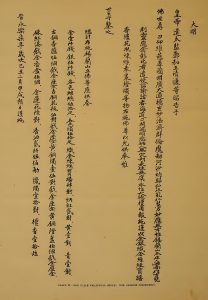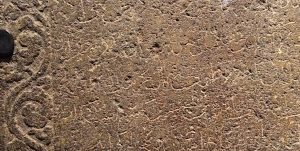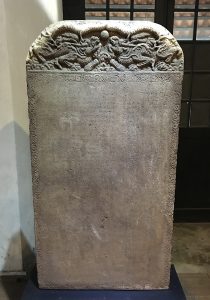OB03167 Jetavanārāma Inscribed Stone Fragment
IN03209 Jetavanārāma Fragmentary Stone Inscription
This inscription is engraved on a fragment of an irregularly shaped octagonal stone slab, which appears from its shape to have originally formed a cross-bar of a railing. The fragment is now in the collection of the National Museum at Colombo. It was unearthed in 1893 by H. C. P. Bell in one of the buildings of the group called monastery L in the extensive monastic complex at Jetavanārāma in Anurādhapura. One end of the slab has broken off and is missing. As a result, the inscription is incomplete. The record can be dated on palaeographic grounds to the third or fourth century A.D. The first line tells us that it is an edict issued in the first year of a king’s reign but, unfortunately, the monarch’s name was inscribed on the lost portion of the slab. The fragmentary nature of the record prevents us from gaining a complete idea of the edict’s purpose but it seems to have been designed to regulate the ecclesiastical affairs of the ancient Sinhalese Buddhist Church. It addresses certain monks whose doctrines are described as needing regulation. These monks were apparently the inmates of some establishments known as the ‘Five Great Residences’. It appears that the king who issued this edict did so under outside influence, the inscription being engraved on a type of stone and using a form of script which were native to the Āndhra country and which are not typically found Sri Lanka. Senarath Paranavitana conjectured that the inscription may relate to the struggle between the monks of the Mahāvihāra and king Mahāsena (r. ca. 334–361), which is described in the chronicles. Paranavitana cited numerous pieces of evidence to support this theory (see Misc. Notes below) but, owing to the fragmentary nature of the edict, no decisive conclusion is possible.
OB03162 Colombo Museum Fragmentary Pillar
IN03203 Colombo Museum Fragmentary Pillar Inscription
This inscription is engraved on all four sides of a fragmentary stone pillar in the collection of the National Museum in Colombo. The provenance of the pillar has not been recorded. It appears to have been repurposed, sometime after it was originally inscribed and erected, as a riser in a flight of steps, resulting in the loss of some letters from the inscription. The text originally continued on the lower half of the pillar, which has been lost. The inscription can be dated on palaeographic grounds to the early tenth century. From the surviving portion of the text, it is clear that the record registered a grant of immunities by a king who had the viruda name of Abhā Salamevan and who is described as a brother of King Sirisaṅgbo Kasub (Sirisaṅghabodhi Kassapa). Senarath Paranavitana argues that the latter monarch is probably Kassapa IV, since he was the only monarch of the name who ruled in this period and had the viruda title Sirisaṅgbo. However, Kassapa IV is not known to have any younger brothers who succeeded him on the throne. Hence the identity of the Abhā Salamevan of the present inscription remains unclear.
OB03160 Vallipuram Gold Plate
IN03152 Galle Trilingual Stele – Chinese Inscription

Galle (Sri Lanka). Stele of Zheng He (鄭和), transcription of Chinese portion. (Zenodo).
The inscription is engraved on a stone slab discovered in 1911 by H. F. Tomalin, the Provincial Engineer at Galle, in a culvert near the turn to Cripps Road within that town and afterwards moved to the Colombo Museum. The slab features inscriptions in three different languages, enclosed within a floral border: Tamil (top-left, IN03150), Persian (bottom-left, IN03151) and Chinese (right). The Chinese inscription is dealt with here.
Following the discovery of the slab, the Chinese inscription was transcribed and translated by Edmund Backhouse. Like the Tamil inscription, it is dated in the second month of the seventh year of Yongle (永樂), the Chinese emperor whose reign began in 1403. The text features praise and offerings dedicated by the Chinese emperor, through his envoys Ching-Ho and Wang Ch’ing Lien, to the Buddha. The other two inscriptions on the slab feature similar lists of offerings but the beneficiary is different in each case, being a Hindu cult deity in the Tamil text and an Islamic saint or shrine in the Persian. It therefore appears that, when the Chinese arrived in Sri Lanka, they made gifts of equal value to several different religious traditions of the region and registered these gifts on the same stele.
IN03151 Galle Trilingual Stele – Persian Inscription

Galle (Sri Lanka). Stele of Zheng He (鄭和), detail of Persian portion. (Zenodo).
The inscription is engraved on a stone slab discovered in 1911 by H. F. Tomalin, the Provincial Engineer at Galle, in a culvert near the turn to Cripps Road within that town and afterwards moved to the Colombo Museum. The slab features inscriptions in three different languages, enclosed within a floral border: Tamil (top-left, IN03150), Persian (bottom-left) and Chinese (right, IN03152). The Persian inscription is dealt with here.
Following the discovery of the slab, the Chinese inscription was successfully transcribed and translated by Edmund Backhouse. However, Rao Bahadur H. Krishna Sastri (Assistant Superintendent for Epigraphy, Madras) and J. Horrovitz (Epigraphist for Moslem Inscriptions in India) failed in their efforts to decipher the Tamil and Persian texts respectively. Sometime later, the Tamil inscription was transcribed and translated for the third volume of Epigraphia Zeylanica (1933: 331–341) by Senarath Paranavitana, who benefitted from having access to Backhouse’s translation of the Chinese text. The Persian inscription is badly damaged but Khwaja Muhammad Ahmad of the Archaeological Department of H. E. H. the Nizam’s Dominions was able to compile a text and translation of the legible portion, which was published in 1933 as an appendix (Appendix B) to Paranavitana’s account of the Tamil inscription.
Following the discovery of the slab, the Chinese inscription was transcribed and translated by Edmund Backhouse. Like the Tamil inscription, it is dated in the second month of the seventh year of Yongle (永樂), the Chinese emperor whose reign began in 1403. The text features praise and offerings dedicated by the Chinese emperor, through his envoys Ching-Ho and Wang Ch’ing Lien, to the Buddha. The other two inscriptions on the slab feature similar lists of offerings but the beneficiary is different in each case, being a Hindu cult deity in the Tamil text and an Islamic saint or shrine in the Persian. It therefore appears that, when the Chinese arrived in Sri Lanka, they made gifts of equal value to several different religious traditions of the region and registered these gifts on the same stele.
OB03125 Galle Trilingual Stele of Zheng He (鄭和)
IN03150 Galle Trilingual Stele – Tamil Inscription
The inscription is engraved on a stone slab discovered in 1911 by H. F. Tomalin, the Provincial Engineer at Galle, in a culvert near the turn to Cripps Road within that town and afterwards moved to the Colombo Museum. The slab features inscriptions in three different languages, enclosed within a floral border: Tamil (top-left), Persian (bottom-left, IN0351) and Chinese (right, IN0352). The Tamil inscription is dealt with here.
Following the discovery of the slab, the Chinese inscription was successfully transcribed and translated by Edmund Backhouse. However, Rao Bahadur H. Krishna Sastri (Assistant Superintendent for Epigraphy, Madras) and J. Horrovitz (Epigraphist for Moslem Inscriptions in India) failed in their efforts to decipher the Tamil and Persian texts respectively. Sometime later, the Tamil inscription was transcribed and translated for the third volume of Epigraphia Zeylanica (1933: 331–341) by Senarath Paranativana, who benefitted from having access to Backhouse’s translation of the Chinese text.
Like the Chinese inscription, the Tamil inscription is dated in the second month of the seventh year of Yuṅlo (Yung Lo), the Chinese emperor whose reign began in 1403 A.D. The text tells us that the Chinese emperor, having heard of the fame of the god Tenavarai-nāyaṉār in Sri Lanka, sent to him, through his envoys Ciṅvo and Uviṅcuviṅ, various kinds of offerings, of which a detailed list is given. Paranavitana notes that Tenavarai is the Tamil name for Devundara (Devunuvara), a settlement near Matara on the southern coast of Sri Lanka which was the centre of a cult dedicated to a deity known as Uppalavaṇṇa. Sometimes like the Purāṇic Viṣṇy in the Hindu tradition, this god was sometimes styled in Sinhalese ‘Devundara Deviyo’, which can be rendered in Tamil as ‘Tenavarai-nāyaṉār’. The other two inscriptions on the slab feature similar (though not identical) lists of offerings but the beneficiary is different in each case, being the Buddha in the Chinese text and an Islamic shrine or saint in the Persian. It therefore appears that, when the Chinese gained political ascendancy over Sri Lanka in 1409, they made gifts of equal value to several different religious traditions of the region and recorded these gifts on the same stone.
